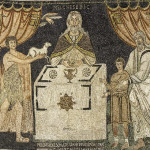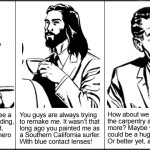We run our website the way we wished the whole internet worked: we provide high quality original content with no ads. We are funded solely by your direct support. Please consider supporting this project.

What the Cross Tells Us About God
Whether we’re talking about our relationship with God or with other people, the quality of the relationship can never go beyond the level of trust the relating parties have in each other’s character. We cannot be rightly related to God, therefore, except insofar as we embrace a trustworthy picture of him. To the extent that our mental picture of God is untrustworthy, we will not rely on him as our sole source of life.
Paul tells us that the gospel is “veiled … to those who are perishing” because “the god of this age has blinded” their minds so that they cannot see “the glory of Christ, who is the image of God” (2 Cor 3:14-15). Satan’s strategy is to attack our conception of God. The root of our alienation from God and our bondage to sin is our untrustworthy and unloving mental pictures of him. Those who are under Satan’s blinding oppression cannot receive the “light” that God wants to “shine in [their] hearts to give [them] the light of the knowledge of God’s glory displayed in the face of Christ” (2 Cor 4:3-6).
Only when the Spirit frees us from the blinding oppression of the “god of this age” can our hearts and minds see the glorious beauty of the God revealed in Christ. And only when we with “unveiled faces contemplate the Lord’s glory” can we be “transformed into his image with ever-increasing glory (2 Cor 3:17-18).
Jesus describes himself as “the way and the truth and the life” (John 14:6). The Greek word for “truth” (aletheia) means something like “uncovered” or “not concealed.” The glorious character of God is fully unveiled in Christ on the cross. As John wrote, no one had “ever seen God” or really known God up to that time. But the Son, “who is himself God … has made him known” (John 1:18).
When Jesus fully unveiled the true character of the one true God on the cross, he “disarmed the power and authorities,” vanquished Satan and his minions (Col 2:14-15), and thereby set free all who would accept the truth.
On the cross, the light expelled the darkness, the truth vanquished all deception, and the beauty of the true image of God destroyed the ugliness of all false images. And so now, for all who will yield to the Spirit, as the veil over our minds is removed, we can see “God’s glory displayed in the face of Jesus” (2 Cor 4:6) and be set free to enter into the loving, trusting, and transforming relationship God has always wanted to have with his people.
The cross is first and foremost the full disclosure of the true character of God and his pledge to demonstrate this loving, self-sacrificial character in all his dealings with us. We are challenged to take him at his word and to reciprocate by cultivating this same character in our relationship with him and all others. We do this not by striving, but by simply gazing on the beauty revealed in the cross with our minds and hearts open to the Spirit.
—adapted from Benefit of the Doubt, pages 235-237
Photo Credit: Jacob Meyer via Unsplash
Category: General
Tags: Benefit of the Doubt, Cross, Cruciform Theology, Jesus, Transformation
Related Reading

Did God Assist the Israelites in the Violent Battle with the Amalekites? (podcast)
Greg keeps his hands in the air as he battles against Old Testament interpretations that portray God as violent. http://traffic.libsyn.com/askgregboyd/Episode_0748.mp3

What’s the Purpose of the Old Testament Law?
Whereas the old covenant was rooted in the law, the new covenant is rooted in simple faith, such as Abraham had. Whereas the old covenant was forged with one particular nation, the new covenant is available to all who are willing to accept it, regardless of their ethnicity and nationality. Whereas forgiveness of sins within…

Podcast: Where is the Foundation of Our Trust in the Old Testament?
Greg looks at what he considers the foundation of trusting in the Bible. http://traffic.libsyn.com/askgregboyd/Episode_0310.mp3

A Cruciform Dialectic
One of the most important aspects of God’s action on Calvary, I believe, is this: God revealed himself not just by acting toward humans, but by allowing himself to be acted on by humans as well as the fallen Powers. God certainly took the initiative in devising the plan of salvation that included the Son…

Another Great Reason to Join Us for the ReKnew Conference: NDY
As if you needed another reason to join us for Faith, Doubt and the Idol of Certainty, I’ll tell you that Greg’s band NDY is playing a free concert at 8:15pm at Woodland Hills Church the Friday night of the conference. Now get on that registration and join us, won’t you?

